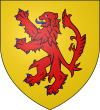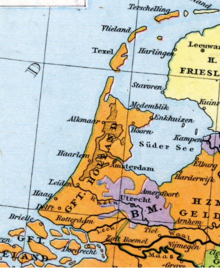County of Holland
|
Territory in the Holy Roman Empire |
|
|---|---|
| County of Holland | |
| coat of arms | |

|
|
| map | |

|
|
| Counties of Holland and Zealand around 1400
|
|
| Form of rule | county |
| Ruler / government | Count |
| Today's region / s |
NL-NH / NL-ZH
|
| Reichskreis | Burgundian |
| Capitals / residences | Haarlem , The Hague |
| Dynasties |
Gerulfinger 1299: Avesnes 1346: Wittelsbacher 1433: Burgundy 1477: Habsburg |
| Denomination / Religions | Roman Catholic |
| Language / n |
Dutch
|
| Incorporated into | 1548: Seventeen provinces
|
Holland was originally a county in the medieval Frankish Empire and later in the Roman-German Empire in Friesland between the Rhine and the Amstel .
history
The county was founded at the beginning of the 10th century by the Frisian leader Dietrich on the territory regained by the Vikings . 922 Dietrich was by King Karl III. accepted. Holland was part of the tribal duchy of Lorraine and with this fell to Eastern Franconia in 925 .
Dietrich's descendants ruled a country, the scope of which gradually grew through drainage and marriage alliances with the count houses of Zealand and Flanders . Under Wilhelm II , who was set up as an anti-king to Emperor Friedrich II in 1247 , Holland first exerted influence in the empire . Due to Wilhelm's untimely death, however, this was only an episode. Wilhelm also moved the residence from Haarlem to The Hague in 1248 - until today the seat of government of the Netherlands .
In 1296 the Frisian line of counts died out, and Holland passed to Johann von Avesnes , the count of Hainaut . In 1299, Seeland also fell to Johann and increased his sphere of influence. Under the Counts of Avesnes and their successors, the Bavarian Wittelsbachers , Holland experienced a period of prosperity that ended with the penetration of Burgundian power - in 1433, Holland fell to Philip the Good . The hook and cod war between 1350 and 1490 was a long smoldering power struggle of the bourgeoisie in the Dutch cities, in alliance with the Burgundian dukes, against the interests of the local feudal nobility .
With the death of Charles the Bold in 1477, the Burgundian inheritance - Holland with the neighboring countries of Zealand , Flanders , Artois , Hainaut , Namur , Brabant , Luxembourg - fell to the Habsburgs . These territories and the other Habsburg acquisitions of Groningen, Friesland, Utrecht with Overijssel and Geldern were initially combined by Charles V in the newly created Burgundian Empire and finally in 1548 to form the constitutional unit of the Seventeen Provinces , within which the provinces, however, remained independent.
In 1555 Charles abdicated in the Seventeen Provinces of the Netherlands in favor of his son Philip II of Spain. The rigid enforcement of the Counter Reformation in the Spanish Netherlands, which was carried out by military force, led to the Eighty Years War from 1568 , in which the seventeen provinces split. Holland joined the other Protestant provinces in 1579, the Union of Utrecht , in which it took the leading position. The Assembly of Estates of the Union of Utrecht, the States General , declared the Republic of the Seven United Netherlands in 1581 and swore Philip II with the Plakkaat van Verlatinghe . With this, the rights of the Count of Holland, which formally remained a county, but was now only referred to as "Gewest" (roughly: region), fell to the States of Holland. The position of governor William I of Orange , who fought on the Dutch side, was retained.
During the entire 200-year existence of the Seven United Netherlands, Holland remained the leading power and determined its politics, which is where the equation of "Holland" with the Netherlands, which is often practiced to this day, comes from. In 1596 Holland's advocate Johan van Oldenbarnevelt negotiated a pact between the Seven United Netherlands and the Kingdom of England . Its support, the economic strength of the United Netherlands itself, especially Holland, and finally the weakening of Spain in the Thirty Years' War or Franco-Spanish War finally led to the recognition of independence by Spain in the Peace of Westphalia in 1648 and a formal dissolution from the Empire.
With the establishment of the unified state of the Batavian Republic in 1795 by Napoléon , Holland was dissolved. The Batavian departments, which were merely administrative units, had different borders. In the course of their multiple changes, however, there was again a Département Holland from 1802 to 1807. After the interlude of the Kingdom of Holland and French annexation , Holland was first restored in 1814 as a province of the Sovereign Principality of the United Netherlands , which was also restored under international law in the Congress of Vienna in 1815 in a greatly expanded form as the United Kingdom of the Netherlands . However, the province of Holland remained an administrative unit without sovereignty. In 1840 the province was split into North and South Holland .
Cities
City foundations in the county of Holland were (selection, in brackets the year in which the city rights were granted):
- Geertruidenberg (1213)
- Dordrecht (1220)
- Alkmaar , Haarlem (1245)
- Delft (1246)
- Suffering (1266)
- Gouda (1272)
- Amsterdam (1300/06)
- Rotterdam (1340)
- The Hague (important, among other things, as a residence, but never formally received city rights)
See also
literature
- Aryeh Grabois: Illustrated Encyclopedia of the Middle Ages. Athenaeum, 1981, p. 281.
Web links
Footnotes
- ↑ Horst Lademacher : History of the Netherlands. Politics - Constitution - Economy . Wissenschaftliche Buchgesellschaft, Darmstadt 1983, ISBN 3-534-07082-8 , pp. 76-77.

